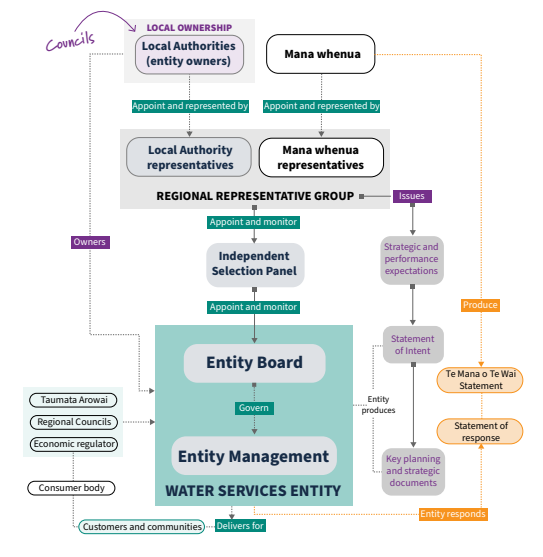Coalition's water reform converging with Labour's water reform

Hot on the heels of having largely reannounced Labour’s Budget 2023 announcement for new trains for the lower North Island, it now appears the National-led Coalition Government’s Local Water Done Well reform package is slowly morphing into something that looks very similar to the previous Labour Government’s Affordable Water reforms.
As more details of how National’s Local Water Done Well are slowly revealed, the latest announcement that any new singular or joint water services council-controlled organisations (CCOs) will be able to borrow up to 500 percent of their revenue through the Local Government Funding Agency (LGFA) is eerily similar to the 600 percent limit that had been suggested under the previous Labour Government’s Three Waters and Affordable Water reforms.
Even beyond the debt limits there are other similarities, even if they’ve been given different terminology under each reform.
For example, the water services CCOs that will likely stem from the Coalition’s reforms are little different in form and function from the water services entities (WSEs) that Labour was looking to create. The water services delivery plans (WSDPs) that Local Water Done Well requires look and sound exactly like the same plans that the Water Services Entities Act required the WSEs to deliver.
Likewise, both the proposed water services CCOs and would-have-been WSEs are largely the same thing - a new class of ring-fenced CCO that has balance sheet separation from the councils that are part of it. The joint local government arrangements that are permitted under the new legislation presumably will end up having to be very similar to the CCOs anyway in order to access higher debt limits.

First, let’s deal with the governance layers. Labour’s reforms sought to use multiple layers of governance and asset transfers to their WSEs to allow them to increase their borrowing limits versus councils. You might remember that under Three Waters/Affordable Water there was going to be a Regional Representative Group made up of council representatives and mana whenua, who appointed an independent selection panel, which appointed a WSE governance board, which then would hire a CEO for the WSE.
Potential joint water services CCO’s under the Local Water Done Well framework seem likely to follow the Wellington Water example, where there’s a regional water committee, which appoints a board to the water services CCO, which in turn governs and hires the CEOs. Even with the removal of mana whenua representatives and no independent selection panel, most of the rest of the requirements from Three Waters/Affordable Water will remain, just with different names. So there’s potentially a slightly simplified governance structure. Though it’s worth noting that constituent councils could - and most likely will - want to appoint mana whenua representatives to their regional water committees, as is the case with the Wellington Water committee.
When it comes to balance sheet separation, the Coalition has taken a couple of different approaches. For Watercare in Auckland they’ve essentially agreed a deal where Auckland Council is banned from providing financial support to Watercare. It’s unclear yet if the same approach will apply to the water services CCOs accessing the additional 500 percent debt headroom, though it seems likely, even if today’s press released stated that the LGFA could provide that additional debt headroom to water services CCOs “immediately”.
It’s also unclear yet whether assets will need to be transferred to these joint water services CCOs, as is the case with Watercare, or whether councils can continue to own them as is the case with Wellington Water. The Local Government (Water Services Preliminary Arrangements) Bill leaves both options open for councils to decide, but it would be surprising if these joint water services CCOs could borrow up to 500 percent of their revenue if they don’t own the assets which generate those revenues and can’t call on their constituent councils for financial support.
This brings us to a current point of difference, but possibly not for long, with Labour’s eventual Affordable Water reforms which had settled on 10 regional entities (up from the four under Three Waters). It may well be that Local Water Done Well’s framework pushes councils to something that closely resembles the entities of Affordable Water.
What makes this likely is that the 500 percent borrowing capacity will only be available to water services entities, and not councils that try to keep their water services and infrastructure under direct control. For smaller councils, standing up their own singular water services CCO might not be economically feasible, so it seems likely they’ll need to sign up to larger, likely regional joint water services CCOs with neighbouring councils. While this probably will mean more than 10 entities, they’ll look far less local than the reform’s name suggests.
Whereas the previous government used legislative compulsion, the Coalition is opting for financial compulsion instead, especially given it’s unlikely most councils will be able to manage the level of capital investment needed in their water infrastructure to meet increasingly tough safety and environmental standards set for them.
None of this is entirely surprising though. There are, after all, only so many ways to skin a cat, and it should come as no great shock that the Coalition’s water reform plan is slowly converging on those of its predecessor. At this stage the main material points of difference are around the still technically (even if not economically feasible) voluntary nature of participating in any water services CCO aspect of the reform, the likelihood of one less layer of governance, and possibly slightly more water services CCOs than there would have been WSEs.
Beyond that, the way the water services CCOs will operate, their debt limits, source for their borrows, and their overall separation from councils remain very similar to what Labour had proposed.



